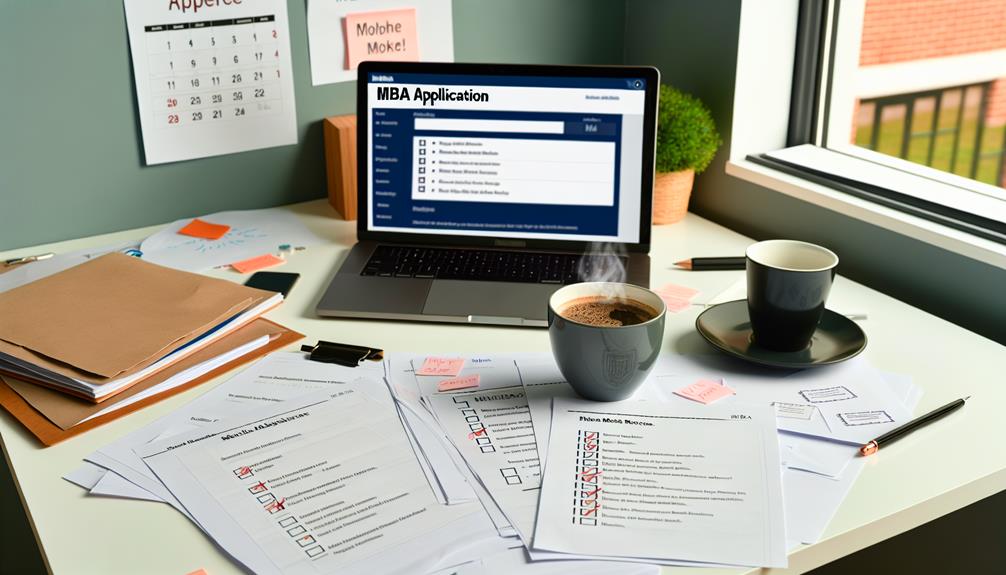To apply for an MBA program in the USA, start by researching different schools and specializations that align with your career goals. Make sure you meet academic requirements, typically a GPA of 3.5 or higher, and prepare for standardized tests like the GMAT or GRE. Craft strong application components, including essays, resumes, and letters of recommendation. Don't forget to check financial considerations, including tuition and scholarship options. Finally, network with current students and alumni for insights. This process can be complex, but stick with it, and you'll discover more helpful tips along the way.
Key Takeaways
- Research MBA programs to understand specializations, rankings, and admission requirements before applying.
- Prepare for standardized tests like the GMAT or GRE, aiming for competitive scores.
- Craft strong application components, including essays, resumes, and letters of recommendation.
- Evaluate financial considerations, including tuition costs, scholarships, and potential student loans.
- Network with current students, alumni, and professionals to gain insights and enhance your application.
Understanding MBA Specializations
When you consider pursuing an MBA, understanding specializations is essential to tailoring your education to your career goals. MBA specializations allow you to focus on specific areas of business that align with your aspirations and the demands of various industries. For instance, if you're drawn to leadership, a General Management specialization can prepare you for strategic roles across diverse sectors, emphasizing decision-making and organizational behavior.
If you're interested in marketing, you might explore specializations that investigate digital marketing, brand management, and consumer behavior, helping you thrive in a competitive marketplace. Alternatively, if you're entrepreneurial, specializations in Entrepreneurship can equip you with the skills needed to innovate, launch startups, or drive growth in established companies.
For those with a technical background, Engineering Management combines engineering principles with business practices, setting you up for leadership roles in tech-focused organizations. Ultimately, choosing the right MBA specialization at business schools not only enhances your skill set but also aligns your education with your long-term career goals. By understanding these options, you can make informed decisions that pave the way for your professional success.
Evaluating Academic Requirements
Choosing the right MBA specialization is just the beginning; evaluating the academic requirements of your desired program is equally important. Most top MBA programs in the USA expect a minimum GPA of 3.5 to 3.7 on a 4.0 scale. If you're aiming for competitive schools, you'll want to exceed this range. Admissions committees often prioritize your performance in junior and senior year courses over your overall GPA, so make sure your undergraduate transcript reflects strong grades during those critical years.
If you're an international applicant, don't forget to convert your academic transcripts into a GPA format and meet English proficiency requirements through tests like TOEFL, IELTS, or PTE Academic. Many business schools also focus on your performance in quantitative courses, as it predicts your potential success in graduate-level coursework.
Preparing for Standardized Tests

Preparing for standardized tests is a crucial step in your MBA application journey. Most MBA programs require test scores from either the GMAT or GRE, and a competitive GMAT score usually ranges from 600 to 700 for top business schools. To maximize your scores, it's advisable to set aside 3 to 6 months for focused study preparation. Use official practice tests and study materials to guide your efforts.
While many schools now offer the option to apply without a standardized test score, you should check specific program requirements. Remember that not submitting scores could impact your application's competitiveness. If you choose to take the GMAT or GRE, keep in mind that test scores are valid for five years. This means taking the test well in advance of application deadlines can give you the flexibility to retake it if necessary.
Additionally, consider enrolling in standardized test preparation courses. These often provide structured study plans and personalized feedback, helping you enhance your performance. With diligent preparation, you can approach test day with confidence, knowing you've done your best to achieve the scores that will strengthen your MBA application.
Crafting Application Components
Crafting your application components is vital for standing out in the competitive MBA admissions process. Start with your admissions essays, which should clearly articulate your motivations for pursuing an MBA, your specific career goals, and how the program aligns with those aspirations. Aim for 500-1000 words, depending on the school's requirements. Authenticity and clarity are key, as you reflect on personal experiences, challenges faced, and lessons learned.
Next, focus on your resume. It should be concise—typically one page—highlighting relevant work experience, leadership roles, and quantifiable achievements like increased revenue or project success rates. This showcases your professional impact effectively.
Lastly, strong letters of recommendation are essential. Choose individuals who can speak to your professional abilities and character, ideally in managerial or leadership roles. They should address specific attributes valued by the business school to enhance your application.
Ensure that all components, including transcripts and standardized test scores, are submitted by the specified deadlines. Late submissions can greatly diminish your chances of acceptance, so stay organized and proactive throughout the MBA application process.
Financial Considerations and Fees

Maneuvering the financial landscape of an MBA program can feel overwhelming, but understanding the costs involved helps you make informed decisions. The average annual tuition for MBA programs in the USA ranges from $60,000 to $150,000, with additional costs like living expenses, books, and materials potentially adding another $20,000 to $30,000. This brings the total cost of attendance to between $80,000 and $180,000.
Here's a breakdown of potential costs:
| Cost Category | Estimated Amount | Notes |
|---|---|---|
| Tuition | $60,000 – $150,000 | Varies by institution and prestige |
| Application Fees | $50 – $250 | Waivers may be available |
| Additional Costs | $20,000 – $30,000 | Living expenses, books, materials |
Many business schools offer scholarship opportunities, which can greatly reduce your tuition burden. Merit-based scholarships are the most common, so be sure to research these options. Additionally, student loans are a viable financing option, but it's essential to take into account the long-term repayment obligations when planning your budget.
Networking and Building Connections
Networking and building connections are essential components of your MBA journey, as they can open doors to valuable opportunities and insights. Engaging with others in the MBA landscape not only enriches your application process but also enhances your overall experience. Here are some effective ways to network:
- Attend MBA Fairs: Meet representatives from various business schools, ask questions, and gain insights about their programs and application processes.
- Leverage LinkedIn: Connect with current MBA students and alumni for firsthand experiences and advice about specific schools and career paths.
- Join Professional Organizations: Participate in events and workshops related to your field, allowing you to network with industry professionals and fellow MBA applicants.
- Engage in Webinars: Take part in school-hosted information sessions to interact with faculty and admissions staff, learning about program offerings and expectations.
Finalizing the Application Process

Finalizing the application process is an essential step that can greatly impact your chances of admission. Start by compiling all required documents. Make certain you have complete and polished transcripts, standardized test scores, letters of recommendation, and a tailored resume. Each component needs to shine before submission.
Next, review and refine your application essays. Go through multiple drafts to guarantee clarity, authenticity, and alignment with the MBA program's values and goals. Don't forget to double-check application deadlines for each business school. Submitting your MBA applications well ahead of these deadlines can help you avoid last-minute issues.
After you submit your application, monitor the status through university portals. Be prepared for potential follow-up communications or requests for additional information. Once you're in the interview stage, research common questions and practice your responses. This stage is essential for demonstrating your fit and commitment to the MBA program.
Frequently Asked Questions
How Can I Apply for an MBA in the Usa?
To apply for an MBA in the USA, start by identifying your specialization and researching accredited schools. Next, prepare for standardized tests like the GMAT or GRE, as most programs require competitive scores. Compile your application materials, including transcripts, a tailored resume, essays, and letters of recommendation. Keep an eye on deadlines, as early submissions can enhance your chances. Finally, monitor your application status and be ready for interviews to showcase your fit.
How Much Does It Cost for an MBA in the Usa?
An MBA in the USA can cost you between $60,000 and $150,000 in tuition alone. Don't forget to factor in living expenses, which usually range from $20,000 to $30,000 annually. Application fees can add up, too, often between $50 and $300 each. Additional costs for textbooks and travel can reach $3,000. Luckily, around half of MBA students receive financial aid, so explore those options to help manage these expenses.
How Much GPA Is Required for MBA in Usa?
To get into a top MBA program in the USA, you're typically looking at a GPA between 3.5 and 3.7 on a 4.0 scale. Some schools might focus more on your GPA from the last two years of your undergrad. If your GPA is lower, don't worry! You can boost your application with strong GMAT or GRE scores and relevant work experience. Remember, the rigor of your coursework matters too!
How to Choose MBA College in Usa?
When you're choosing an MBA college in the USA, start by researching the curriculum and specializations that align with your career goals. Look into the school's reputation and accreditation through rankings and alumni success. Consider the network opportunities available, as they can greatly impact your career. Don't forget to check application deadlines and overall costs, including tuition and living expenses, to make certain you make an informed decision that fits your financial situation.
